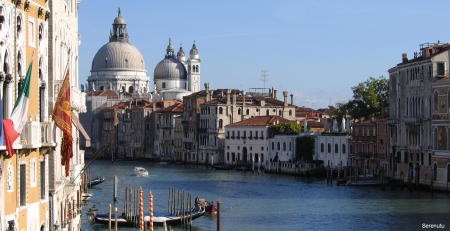
La Repubblica Serenissima
Venice at one time was a mighty city-state republic, defying the Austrians, the Turks, Germans, French the other City states of Italy and even the Pope. Its riches and power extended the entire Adriatic Coast and as far as the Black Sea. The very isolation of the islands, huddled together out in the lagoon, protected it from attack for hundreds of years and aided its rise to power. This same isolation is now slowly strangling the Republic.
Imagine a collection of hunters and fishermen living in simple huts on the muddy edge of a huge lagoon studded with hundreds of tiny islands. The lagoon is rich with fish, the nearby woods filled with deer and wild boar. Why would anyone venture out on these barren islands? The arrival of barbarians might.
This population of hunters and fishermen, who escaped from the mainland to the collection of islands in order to evade the invading Huns, built more substantial houses and churches and bridges to link the islands. Contact with the mainland became more and more abstract and in 726 Venice broke from the controlling empire of Ravenna and chose a leader, the first doge. Then, in a crystal clear message of independence, the Venetians stole the body of St Mark from Alexandria in 828 and installed it in the newly constructed basilica. They felt it was destiny, but this bold move marked the start of what was called la Repubblica Serenissima or, the Serene Republic, and the land for hundreds of kilometers came under the control of the merchants and politicians grown rich on the lucrative trade with the East. They in turn provided protection and stability to the stretch of mainland which is now known as the Veneto. La Republica Serenissima lasted for hundreds of years until Napoleon shut the party down in 1797.
Even as the rest Italy struggled with local kings and powerful Popes, Venice remained separate, aloof from such riff-raff. When Italy finally pulled itself together and unified into one country in 1861, the Veneto was reluctant, dragging its heels. A plaque in Treviso notes that the local vote to decide whether to join the illustrious republic of Italy finally took place in 1866. Carved in stone we can observe for eternity that on October 21st of that year, 84526 citizens voted “yes” and 2 citizens, resistant to the very end, voted “no”.
It is difficult to nail Venice down. Try as I might, even after four years here, I still do not understand it. It is like trying to paint a gust of air. It is moving, transparent, light and does not really exist. However, from time to time I make a new attempt to figure it out. Meanwhile, here are some interesting links to Venice and the Veneto that could lead you to places beyond the crush of San Marco Square and maybe a better understanding of the Serene Republic.
www.deliciousitaly.com
www.travelplan.it
www.trenitalia.com
www.initaly.com
www.whatsonwhen.com
www.veneto.to/portal





